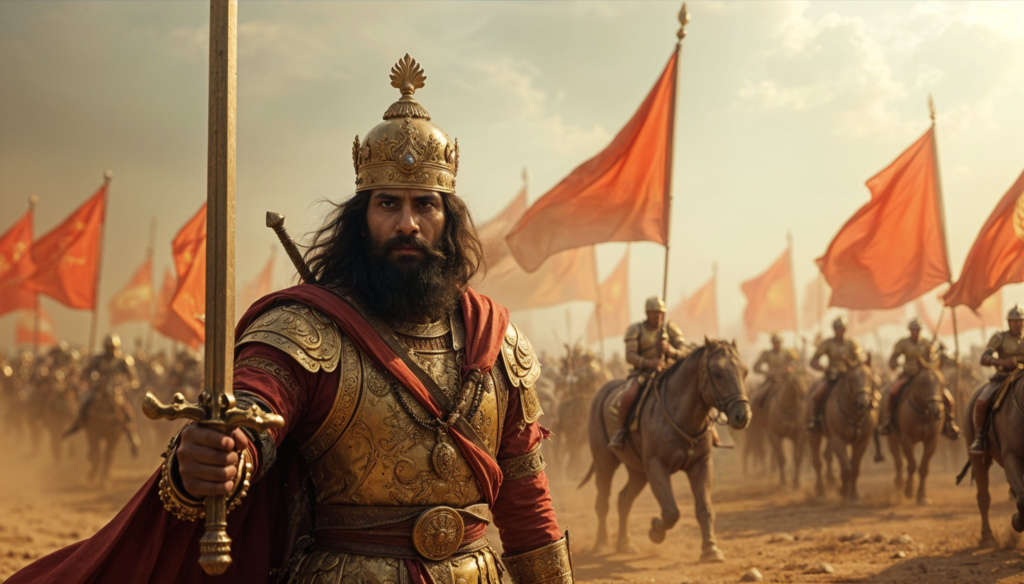For centuries, the civilization of Bharat stood apart for its profound respect for knowledge, wisdom and equality. It is a matter of great Interest for many that the ancient Bharat’s philosophy did not distinguish an individual on the basis of gender. Infact both men and women enjoyed equal opportunities in all kinds of vocations including Philosophy, Knowledge, Shastra, Tark Shastra, debate, Politics, governance. Women in India were Philosophers, poets, political advisers, Vedic exponents and ancient scientists. They composed hymns of Rigveda, led philosophical debates in royal courts and guided kings with wisdom and political acumen.
Women sages like Gargi Vachaknavi and Maitreyi both great Vedic scholars debated profound metaphysical concepts with sages like Yajnavalkya. Lopamudra wife of sage Agastya was a philosopher in her own right. Queen Vishpala is mentioned in Rigveda as a warrior who fought battles with an iron leg. Later in the History of Bharat several queens like Rani Durgavati, Rani Avantibai, Rani Laxmibai, Rani Abbakka, Rani Chennamma, Rani Velu Nachiyar, Rani Ahilyabai Holkar and many more ruled with capability and courage. The legacy of gender parity, however began to erode with the advent of medieval Izlamic invasions and resultant rigid religious customs. Such Foreign invasions, feudal structures and societal response mechanism to save women led to conservatism which eventually pushed Indian women behind veils and walls curbing their rights to education and freedom.
However, one woman changed the course of time refusing to accept child marriage, challenging the British Indian legal system and becoming India’s first practicing woman doctor. She was none other than Rukhmabai Raut, born in Bombay Presidency in the year 1864 defied these societal constraints and embarked on a journey that would go on to redefine women’s empowerment in Bharat.
A Challenging Beginning
Rukhmabai’s early life was filled with challenges and extreme adversity. Her mother Jayantibai, herself was a victim of child marriage and was married off at a young age of just 14 years. She gave birth to Rukhmabai at 15, and tragically become a widow at just 17. Jayantibai refused to bow down to fate and took a bold step to get remarried to Dr Sakharam Arjun Raut a progressive thinker and a renowned Physician. This re-marriage itself was a radical act in the 19th century India, where widows were expected to live in isolation. Dr Sakharam Raut, was a staunch supporter of women’s education and social reforms became a pivotal figure in Rukhmabai’s life. Recognizing Rakhmabai’s intelligence and curiosity in academics he encouraged her to pursue education –something rare and even frowned upon for girls at the time.
Defying Child Marriage
Due to prevailing societal pressure at just 11 years of age, Rukhmabai was married off to Dadaji Bhikaji, who was aged 19 at the time. However unlike other girls of her era Rukhmabai refused to live with her husband. Instead she continued her education under her stepfather’s guidance. As she blossomed into an intelligent and cultured young woman, she discovered that her husband had questionable character traits and little interest in education. Terrified of being in a stifling and loveless marriage, Rukhmabai decided she could not remain tied to such a man.
The Iconic Court Case that shocked even the British India
In March 1884, her husband Dadaji approached the court demanding that Rukhmabai come and live with him. Rukhmabai, still studying in school, refused. What followed was a sensational court case that shook the foundations of the social practice of child marriage and conjugal rights in India at that time. Rukhmabai challenged her husband’s claim to conjugal rights, leading to a legal battle that captured national attention.
Her husband moved court and managed to get a “Court Order” to get her to move into his house and live with him, but she steadfastly refused again. The court presented Rukhmabai with a stark choice: comply with its order or face imprisonment. Rukhmabai in the court argued courageously and said “she would prefer going to jail for violation of court orders than to stick to a marriage she never consented to”. Her argument was way ahead of her times and unprecedented. She argued that she couldn’t be forced into a marriage that occurred when she was too young to give a consent and incapable to take right decisions of life. This case became one of the most publicized court battles in India and even in the west
Several reformers of the time like Ramabai Ranade and Behramji Malbari rallied around her cause forming the “Rukhmabai Defence committee”. This case gained widespread coverage even in British newspapers and even Queen Victoria herself expressed sympathy with Rukhmabai and demanded justice for her.
However, in the year 1888 the case reached a turning point when a compromise was reached, and Dadaji accepted an out of court settlement for a monetary compensation in lieu of dissolving the marriage. This out of court settlement became a landmark moment in colonial India, shedding light on critical issues pertaining to women’s right to consent and marriage.
Educational Pursuits and Medical Career
Finally liberated from the shackles of her marital constraints, Rukhmabai embarked on a remarkable journey. Impressed with her resilience and her academic record, the then British director of Bombay’s Cama Hospital helped her in enrolling at the London school of Medicine for Women. Rukhmabai up against this new challenge to study at a foreign country pursued her dreams of becoming a doctor and finally passed with flying colours in the year 1894.
Returning to India, Rukhmabai initially faced ostracization despite her stellar accomplishments. Undeterred she continued on her path to service eventually becoming the chief medical officer in Surat where she served with distinction for over 35 years. Throughout her life she championed social reforms, advocating against child marriage and women’s seclusion (purdah). Remarkably, she never remarried and remained active until her passing in 1955, leaving behind a legacy of courage and resilience.
Her untold story deserves recognition and celebration, as it illuminates the path for countless others who dare to dream beyond societal constraints.




